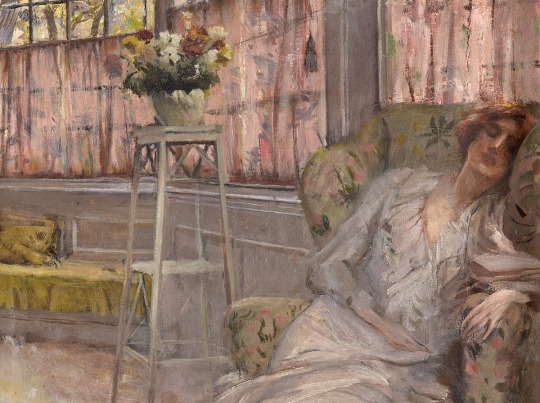#winnaretta singer
Photo

Winnaretta Singer, Princesse Edmond de Polignac (8 January 1865 – 26 November 1943) was an American-born heiress to the Singer sewing machine fortune. She used this to fund a wide range of causes, notably a musical salon where her protégés included Debussy and Ravel, and numerous public health projects in Paris, where she lived most of her life. Singer entered into two marriages that were unconsummated, and openly enjoyed many high-profile relationships with women.
#Winnaretta Singer#women in history#lgbtqa+#people#portrait#paintings#art#arte#XIX century#XX century
58 notes
·
View notes
Text
Possible inspiration for Maud Beaton?
Someone on the tga subreddit mentioned Winnaretta Singer as a possible inspiration for the character of Maude Beaton so, I decided to look into it. If Maud is a lesbian and she and oscar are headed towards a lavender wedding, Singer would be an interesting source of inspiration.
This is an interview with a biographer of hers. The biography studies music, so a lot of the vid is her recounting Singer's contribution to music through her salon (at 5:17 they get more into her personal life):
youtube
If her life really is inspiration for the oscar plot, we could get a rough idea of what the rest of the season looks like if her life really is inspiration for the oscar plot in season 2. From looking at her second husband Prince Edmond de Polingnac's wikipedia, it seems like he was an older gay man who had had long term relationships with men in the past. Edmond was the inspiration of some famous characters and is described as "using his wit to shield himself from sincere emotion". He seems to have started his relationship with Singer after loosing a lot of money due to bad investments.
With what we know from previews and spoilers and what I found online here is a possible shape of the rest of the season. Maud could be a closet lesbian who wants to marry Oscar for his social pedigree and the freedom he offers. They could become friends and ultimately marry to help solve Oscar's financial situation. They may have a mutually beneficial situation with differing ideas on what marriage is about. If this is the case it could be interesting to see where they differ on the topic of having kids (something oscar cites as his reason for wanting to get married).
Anyway those are my meager findings. If you are interested I for sure recommend reading more about Singer and de Polingnac.
#manifesting the lavender marriage#Regardless of whatever happens in this tv show#what an interesting woman to learn about.#the gilded age#oscar van rhijn#maud beaton#Prince Edmond de Polingnac#TGA theory#tga spoilers#Winnaretta Singer
11 notes
·
View notes
Photo

Winnaretta Singer (American, 1865-1943): Etude d'intérieur (1896) (via Düsseldorfer Auktionshaus)
130 notes
·
View notes
Text
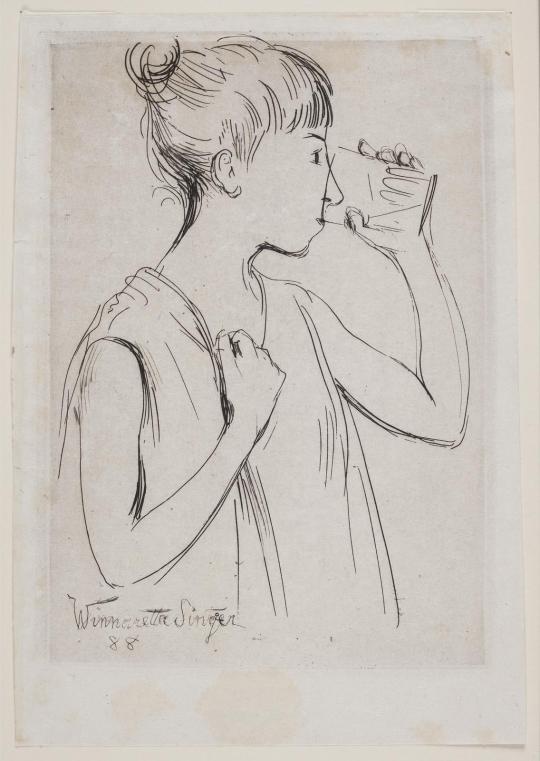
Young Woman Drinking, Winnaretta Singer, 1888
1 note
·
View note
Text

Winnaretta Singer - Etude d´Interieur (1896)
196 notes
·
View notes
Text
Me: *innocently researching names*
Baby name description: "An invented name most notably borne by Winnaretta Singer, heiress to the Singer sewing machine fortune. Singer spent most of her life in Paris after marrying Prince Louis de Scey-Montbéliard. Their marriage was never consummated — Singer reportedly threatened to kill her new husband if he touched her. She had numerous affairs with women over the course of her life, including with painter Romaine Brooks, composer Ethel Smyth, and Virginia Woolf."
68 notes
·
View notes
Text
Happy International Women’s Day!
Here are some incredible queer women to learn about today!
Sonia Rescalvo Zafra
Kate O'Brien
Agnes Goodsir
Ethel Pedley and Emmeline Woolley
Anna Blaman
Chavela Vargas
Winnaretta Singer
Yosano Akiko
Maria Dąbrowska
Hilda Käkikoski
Tove Jansson
Holly Woodlawn
Carmen Rupe
Elisa and Marcela: The First Same-Sex Marriage in Spain
Victoria Arellano
Evelyn Irons
Princess Vera Gedroitz
tatiana de la tierra
Lesley Gore
Princess Isabel of Parma and Maria Christina, Duchess of Teschen
Jane Addams
Amrita Sher-Gil
Elvira de la Fuente Chaudoir, A.K.A Agent Bronx
Jeanette Schmid
Cássia Eller
Eleanor Rykener
Coccinelle
Dawn Langley Hall
Catherine Bernard: A question in studying asexual history
Kitty Genovese
184 notes
·
View notes
Text
THIS DAY IN GAY HISTORY
based on: The White Crane Institute's 'Gay Wisdom', Gay Birthdays, Gay For Today, Famous GLBT, glbt-Gay Encylopedia, Today in Gay History, Wikipedia, and more … April 19



1759 – August Wilhelm Iffland the German actor, playwright and librettist was born on this date (d.1814). Iffland was a powerful force in the German theater of the 18th century, even though his plays are generally unknown outside his native country.
In 1810, he was "outed" by Heinrich von Kleist, the poet, author and playright. Kelist offered August Wilhelm Iffland, who at that time was the director of the Nationaltheater, the chance to stage his play Käthchen of Heilbronn. When Iffland refused, Kleist branded him a homosexual.
On 1 October 1810, Kleist surprised the people of Berlin by setting up a daily newspaper. The Berliner Abendblätter appeared every day except Sundays for half a year in the convenient octavo format at a price of eight Pfennigs. The newspaper provided a diverse mixture of information to suit every taste: police announcements, military anecdotes, poems, aesthetic essays such as Kleist's famous article "On the Marionette Theatre", critical looks at the Prussian government, and polemic attacks on Iffland's theatre and his homosexuality. Kleist's paper was shut down by Germain authorities and the attacks ceased. Kleist committed suicide soon after.
Iffland died in Berlin on 22 September 1814. A bronze portrait statue of him was erected in front of the Mannheim theater in 1864. A street in Berlin is named after him. The Iffland-Ring bears Iffland's likeness, and is borne by the most important German-speaking actor, as decided by his predecessor.

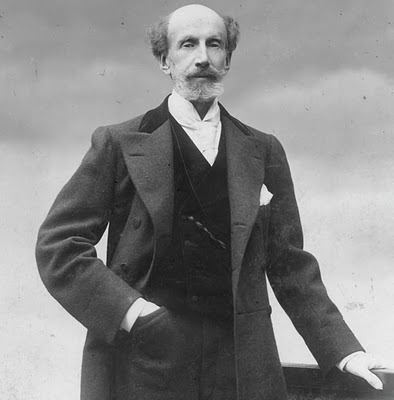
1834 – Prince Edmond De Polignac the French composer was born on this date (d.1901). A descendant of one of the more illustrious families of France. His father Auguste Jules Armand Marie, Prince de Polignac (1780-1847) was the Minister of State in the Restoration government of King Charles X, and was the author of the Thirty Ordinances in 1830, which revoked the Constitution, suspended freedom of the press, and gave the king extraordinary powers, including absolute power in the name of "insuring the safety of the state".
In 1875 a new friend entered de Polignac's life, Comte Robert de Montesquiou, a beautiful and intelligent man twenty-one years his junior. They shared many interests, and began an intimate relationship at that time. In his later years, Montesquiou used his wit to shield himself from sincere emotional interaction. He is remembered as a model for Des Esseintes in Huysman's A Rebours, and the Baron de Charlus in Proust's À la recherche du temps perdu. Through Montesquiou's circle, Polignac made the acquaintance of Elisabeth, comtesse Greffulhe and of Gabriel Fauré, and became a member of the Société Nationale de Musique, where his compositions were performed alongside those of Chausson, Debussy, and Fauré.
By 1892, Polignac, inept with money and impoverished through investments in a series of get-rich-quick schemes, was destitute; his nephews helped him with loans, but noted that desperate action was needed. The solution they suggested was marriage to a woman of appropriate means. Polignac discussed the matter with Montesquiou, and Montesquiou with his cousin Élisabeth Greffulhe, and out of these conversations the name of Winnaretta Eugenie Singer, daughter of Isaac Singer, the sewing machine tycoon, with her marriage to Prince Louis de Scey-Montbéliard lately annulled, arose.
Singer's social status could be improved by marrying a prince, even a poor one. And the arrangement would have other benefits: Winnaretta was Lesbian and not sexually interested in men at all. She was intimately interested in music, however, something the two did have in common.
Polignac asked the Comtesse Greffulhe to sound out Madame Singer on the subject of a mariage blanc (unconsummated marriage), in which each partner would have their own bed but would share artistic interests. Montesquiou, who collaborated with Winnaretta on some artistic projects, asked her to speak with Madame Greffulhe, and there the arguments were reviewed; her social position, compromised by divorce, would be improved by an alliance with one of the oldest and most distinguished aristocratic families in France; with the thirty-one year age difference, and the predilections of the bride and groom, Winnaretta would be free to lead her personal life as she wished, with no sexual demands from Edmond.
The advantages clear, a friendship and affection grew. In November 1893, Edmond proposed marriage to Winnaretta, and she accepted, a year after the idea had first been broached. On 15 December 1893 the couple were married by the Abbé de Broglie in the Chapelle des Carmes. The union received the blessings of Pope Leo XIII.
Montesquiou felt slighted when Edmond was not sufficiently grateful, and the friendship was irrevocably broken.
Ed. Note: The house of Polignac is also (technically) the current Princely House of Monaco; Prince Ranier (late husband of Grace Kelly) was the son of a Monagasque princess and a Polignac. For patriotic reasons, the princely house still keeps the name Grimaldi, though it has passed through the female line a couple of times. This is certainly a family with an interesting past and present.


1913 – The Illinois Supreme Court rules that cunnilingus is not a "crime against nature" under that's state's sodomy law, even though the Court had ruled fellatio to be one due to the state's unusually broad language.


1946 – Tim Curry, British actor and famed on-screen outerspace transvestite was born on this date. Curry's first full-time role was as part of the original London cast of the musical Hair in 1968, where he first met Richard O'Brien who went on to write Curry's next full-time and perhaps still most famous role, that of Dr. Frank-N-Furter in The Rocky Horror Show. Originally, Curry rehearsed the character with a German accent and peroxide blond hair, but the character evolved into the sly, very upper-class English mad scientist and transvestite that carried over to the movie version of The Rocky Horror Picture Show and made Curry both a star and a cult figure.
He continued to play the character in London, Los Angeles, and New York until 1975. For many years, Curry was reluctant to talk about Rocky Horror, feeling that it was a trend that had gone too far and had distracted attention away from his later roles.
On 23 May 2013, Curry was reported to have suffered a major stroke at his home in Los Angeles. Although many sources suggested the stroke had made it difficult for him to speak, his longtime agent Marcia Hurwitz told the Daily Mail "Tim is doing great," and that 'He absolutely can speak and is recovering at this time and in great humour'. Shortly after the initial report, Hurwitz told The Hollywood Reporter that the stroke actually occurred in July 2012, and that Curry had been going to physical therapy. As a result of the stroke, he uses a wheelchair.


1967 – The Student Homophile League of Columbia University becomes the first U.S. gay college group to obtain a campus charter. The SHL had twelve members who fought with university administrators for a year before the group was officially recognized.
Stephen Donaldson, a bisexual-identified LGBT rights activist is commemorated by a plaque in the Queer Lounge that bears his name in one of Columbia’s residence halls for spearheading the creation of the group.
When the charter was ultimately granted in April 1967, it earned media attention with the New York Times printing a story on the front page. The Columbia Daily Spectator reported that some students believed that the creation of the group was an April Fool’s joke. The group is still in existence to this day and is now called the Columbia Queer Alliance


1978 – James Franco is an American actor, filmmaker, and teacher.
His first prominent acting role was the lead character Daniel Desario on the short-lived cult hit television program Freaks and Geeks. He later played the title character in the TV biographical film James Dean (2001), for which he won a Golden Globe Award. He played Harry Osborn in Sam Raimi's Spider-Man trilogy (2002–2007). He is also known for his roles in the films Flyboys (2006), Pineapple Express (2008), Milk (2008), 127 Hours (2010), Rise of the Planet of the Apes (2011), Oz the Great and Powerful (2013), Spring Breakers (2013), This Is the End (2013) and The Interview (2014). He had a recurring role in the ABC soap opera General Hospital. For his role in 127 Hours, Franco was nominated for an Academy Award for Best Actor.
Franco volunteers for the Art of Elysium charity and has taught a class at New York University in feature filmmaking and production. In 2013, he began teaching a course in short film production at the University of Southern California and a course in screenwriting at his alma mater, University of California, Los Angeles.
In response to questions regarding his sexuality now that he has portrayed three gay characters during his acting career, he insists he finds plenty more dimensions to the characters than their bedroom proclivities. "Or, you know what," he quipped, "maybe I’m just gay."
Those rumors led to a Gawker article linking him to a New York Post Page Six blind item about a closeted gay actor, nicknamed "the Gay Rapist". Despite the victim of the alleged attack denying that it was Franco, two magazines then contacted Franco's lawyer to alert them that they might run stories suggesting his involvement, but were unable to, as at least part of their stories were fabricated. However, Gawker refused to take their article down as they were simply reporting what another outlet published and instead offered him a chance to make a comment about the speculation on its website. He declined, hoping it would die down. The actor later called the episode very offensive because he has friends who have been raped.
In I Am Michael (2014), he plays real-life figure Michael Glatze, a former gay activist who leaves his boyfriend (Zachary Quinto) behind after declaring himself straight and becoming a pastor.
Franco says of the gay content of many of his projects:
"Some of it's coincidence, or the gay aspect of the project — like Hart Crane in The Broken Tower or Allen Ginsberg in Howl — is secondary. It wasn't like, 'We need to do this because he was gay.' It's because of their art, and then their art was partially informed by their sexuality. But then with something like Interior Leather Bar or Milk, those are obviously engaging with gay themes, gay rights, gay politics. In the case of Milk, once I did that movie, it kind of opened me up to a lot of things I hadn't really thought about because they hadn't been a part of my life. Lee Daniels says that gay rights are the civil rights of our era, so I like doing a movie like Milk or Interior Leather Bar where I can bring themes and ideas I've been engaged with, and do it in such a way that those ideas are pulled into the mainstream more."
In a March 2015 interview with Four Two Nine magazine, Franco again opened up about his sexuality, commenting that it is not who you have sex with that defines your sexuality, but instead how you act. "In the twenties and thirties, they used to define homosexuality by how you acted and not by whom you slept with. Sailors would fuck guys all the time, but as long as they behaved in masculine ways, they weren’t considered gay". Franco added, "Well, I like to think that I’m gay in my art and straight in my life."


1982 – The Gay Officers Action League, Inc. is founded by NYPD Sergeant Charles Cochrane and retired Detective Sam Ciccone etablishing the first official police fraternal society in the world to represent LGBT people within the criminal justice system.
Sergeant Cochrane, a 14 year veteran of the NYPD, created shock waves by testifying before a NYC Council hearing in favor of a gay rights bill. Following the testimony of a Patrolmens Benevolent Association Vice President, who denounced the bill and declared, "I didn't know of any homosexual police officers.", Cochrane stunned all present as well as NYC as a whole by his testimony: "I am very proud of being a New York City Police Officer, and I am equally proud of being gay."
In 1987, at the persistent urging of GOAL, NYPD began a concerted effort to actively enlist qualified gay candidates. In 2002, GOAL was admitted into COPS, The Committee of Police Societies, an organization consisting of all recognized NYPD religious, ethnic fraternal organizations.
Since its ineption, GOAL has evolved not only as a fraternal organization, but also as an activist organization that represents the interests of its LGBT members in all agencies and branches within the criminal justice system.


1992 – James Scully is an American actor, best known for portraying JD in the Paramount Network series Heathers (2018) and Forty Quinn in the Netflix thriller series You.
Scully was born and raised in San Antonio, Texas. In his youth, he spent a brief period in England when his father was stationed there as a part of the United States Air Force. He later attended Otterbein University, where he earned a Bachelor of Fine Arts in musical theater. Scully was also a cycling instructor for three and a half years at SWERVE Fitness.
Prior to working in Los Angeles, Scully resided in New York performing Off-Broadway. In 2016, Scully made his acting debut in the web series drama series, Sublets. Following on from his first role, Scully later made appearances in television series, such as Quantico and 9-1-1.
He has also done commercial work for Outback Steakhouse and a public service announcement about Vicodin abuse with Riverdale actress, Camila Mendes.
In 2018, Scully starred in the main role of JD on the Paramount Network series Heathers. In January 2019, it was announced that Scully had been cast as Forty Quinn on the second season of the Netflix thriller series You.
Scully is openly gay

1995 – Arizona revises its sex offender registration law to remove sodomy from the list of compulsory registration categories, but permits judges to order registration if the defendant committed sodomy for "sexual motivation."???


11 notes
·
View notes
Text
so during my dive into singer sewing machines I discovered three things
My great great grandmother has a sewing machine so fucking old I can not find anything about it
Isaac Singer did not have children as people no he had a number and that number was 26
one of those numbers was Winnaretta Singer a lesbian and a heiress to singer fortune and she absolutely fucked
3 notes
·
View notes
Photo

Isabella Eugénie Boyer was a French-American model and heiress. She was born in Paris to Louis Noël Boyer, an Africa-born French confectioner, and his English-born wife Pamela Lockwood (aka Pamilla). She married Isaac Merritt Singer, the founder of the Singer Sewing Machine Co., in New York City, in 1863 when Isaac was 52 and Isabella was only 22. Singer had a previous common-law wife, Mary Ann Sponsler, who had Isaac arrested for bigamy.
Isabella and Isaac moved to Paris, then to Oldway Mansion in Paignton, on the Devon coast, because New York society frowned on his many "families." They had six children; Sir Adam Mortimer Singer (1863—1929), Winnaretta Eugénie Singer (1865–1943), Washington Merritt Grant Singer (1866–1934), Paris Eugene Singer (1867–1932), Isabelle-Blanche Singer (1869–1896) and Franklin Merritt Morse Singer (1870–1939).
Isaac Singer is reported to have had a total of 22 children with his many paramours. Singer died in 1875 and left an estate of about $14 million, which at the time was a colossal sum of money. His two wills created family tension and lawsuits. Isabella was declared his legal widow.
On 8 January 1879, Isabella married a Dutch musician, Victor Reubsaet, and settled in Paris. Victor was an internationally successful singer and violinist. He was born in 1843 in Sittard, as Nicolas Reubsaet, a son of a simple shoemaker. Pretending to be of noble descent, he falsely claimed the title Vicomte d’Estenburgh. In 1881, he did obtain the title of Duke of Camposelice from Italian King Umberto I, in appreciation for a generous act of philanthropy in favor of the Italian colonies.
The Duchess of Camposelice was still a striking lady when she met the sculptor Bartholdi. It is rumoured she was his model for the Statue of Liberty, however this claim may not be correct.

Victor Reubsaet died in September 1887 and Isabella was married, for the third time, in December 1891, to the art collector Paul Sohège.
Isabella Eugenia Boyer died at 62 years of age in 1904 in Paris.
In March 2022, an image supposedly showing Isabelle Boyer-Singer was widely circulated on social media, along with the claim that she was the original model for the Statue of Liberty. Well, that image still continues to circulate on the internet with the same caption, but it is not a photograph of Isabelle. It isn’t a photograph at all. It was created by photographer Bas Uterwijk in 2021, as part of a series of “AI portraits” of historical figures. Born in Amsterdam, Bas has a background in computer graphics, 3D animation, and special effects.
Anyway, while the Statue of Liberty is undoubtedly Bartholdi’s most famous work, he was very well known for another project. Years before he began the Lady — a gift from the people of France to the people of the United States, dedicated on October 28, 1886, and named Liberty Enlightening the World, in French La Liberté éclairant le monde — Bartholdi was hired to design a statue planned for the entrance to the Suez Canal in Egypt. A project inspired by ancient giant Egyptian statues and, eventually, to the Colossus of Rhodes, but that was never actually built due to high expenses.
Daily inspiration. Discover more photos at http://justforbooks.tumblr.com
25 notes
·
View notes
Photo

Prince Grégoire Bibesco-Bassaraba de Brancovan (12 December 1827 – 15 October 1886) was a #romanian #french prince. Villa Bassaraba just west of #evian at Amphion-les-Bains, was a gathering place for music and poetry lovers, including Marcel #proust , Prince Edmond de #polignac , the Princess de Polignac (formerly Winnaretta Singer, a daughter of Singer sewing machine fortune founder Isaac Singer), Prince Antoine Bibesco, and the novelist Abel Hermant. (à Évian-les-Bains) https://www.instagram.com/p/Cm318JrrW2-/?igshid=NGJjMDIxMWI=
1 note
·
View note
Text
Čaławiek u čyrwonym palito
"Čaławiek u čyrwonym palito" anhielskaha piśmieńnika Džulijana Barnza
[The Man in the Red Coat by Julian Barnes]
Histaryčna-bijahrafičny twor raskazwaje pra Pieknuju epochu (La Belle Époque) — peryjad francuskaj historyi pamiž Franka-pruskaj i Pieršaj suświetnaj wojnami (1871-1914), jaki charaktaryzawaŭsia miram, kulturnym, ekanamičnym i technalahičnym roskwitam — praz žyćcio chirurha j hinekolaha Samuel Jean Pozzi. Sama nazwa knihi kaža nam, pra kaho pojdzie haworka - čaławiek u čyrwonym palito j jość Pozzi; takim jaho napisaŭ mastak John Sargent.

Apowied pačynajecca letam 1885 roku, kali try francuzy — Prync, Hraf i zwyčajny čaławiek biez dwaranskaha tytułu dy z italjanskim proźwiščam — prybywajuć u Londan. Apošni j jość Samuel Pozzi— niepraduziaty j razumny nawukowiec z zabłytanym asabistym žyćciom, jakoje razyhrywajecca na fonie Pieknaha wieku. Ale nawat u toj pieknaści byli swaje ahidnyja baki: histeryja, samalubawańnie, dekadenctwa, praduziataść, skandały, plotki — karaciej, usio toje, što dahetul charaktaryzuje ludziej. Kali prawieści paraŭnańni pamiž tym i sučasnym hramadztwam — što aŭtar dazwalaje sabie rabić niešmatlikimi trapnymi kamentarami — ŭzhadwajecca fraza "ničoha nie źmianiłasia".
Twor, adnak, nie źjaŭlajecca suchoj bijahrafijaj Pozzi — aŭtar majsterski pieraplataje žyćci znakamitych dwaranaŭ, piśmieńnikaŭ, mastakoŭ, filozafaŭ, nawukoŭcaŭ, i h.d. Siarod imionaŭ, jakija ŭzhadwajucca ŭ knizie: Guy de Maupassant, Robert de Montesquiou, Joris-Karl Huysmans, Oscar Wilde, Marcel Proust, John Singer Sargent, Sarah Bernhardt, Alfred Dreyfus, Rudyard Kipling, i inšyja.
Da taho-ž, jak anhielski piśmieńnik, aŭtar nie zabywaje ŭzhadwać Brytaniju j składanaje staŭleńnie francuzaŭ da brytanskaha hramadztwa. Naprykład, Pozzi apiswajecca, jak adkryty čaławiek, jaki hrebawaŭ šawinizmam; jon paraŭnoŭwaŭ šawinizm ź nieadukawanaściu, stanoŭča stawiŭsia da Amerycy, uwažaŭsia za anhłafiła. Na kantraście ŭzhadwajecca Guy de Maupassant, jaki paśla wizytu ŭ Londan žaliŭsia na choład i doždž, a taksama niekarektna adzywaŭsia pra tutejšych łedzi, i bolš nikoli ŭ žyćci nie wiartaŭsia tudy.
U knizie zatronuty temy homaseksualizmu, seksizmu, šawinizmu, relihii, šlubu, adnosinaŭ pamiž baćkami j dziećmi, taksama na asobnych prykładach raskazwajecca, jak pracawała sudowaja systema, jak raźwiwałasia chirurhija, i hetak dalej — byli zatronutyja amal usie temy, jakija možna było zatronuć, kab jak maha lepš acharaktaryzawać hramadzstwa toj epochi.
Naprykład, u časie adnaho sudowaha pracesu, praŭnik śćwiardžaŭ, što jaho klijent stralaŭ nia ŭ Drejfusa-čaławieka, a ŭ ideju Drejfusizmu. Arhument byŭ pryniaty j strałka apraŭdali. Francuski sud taho času prymaŭ abstraktnyja idei j lubiŭ kiemliwyja arhumenty bolš za fakty. Oskar Ŭajłd, jaki widočna zachaplaŭsia Francyjaj, sprabawaŭ prawiarnuć padobnaje ŭ Brytanskim sudzie, ale marna.
Postaci Oskara Ŭajłda pryświečana šmat radkoŭ. Jon śćwiardžaŭ, što mastactwa isnuje dziela mastactwa, što mastactwa nia maje dačynieńnia da pytańniaŭ maralnaści j amaralnaści, i što meta mastactwa prosta charastwo, a samo mastactwa "nie ŭpływaje na dziejańnie". Śćwiardžajecca, što małady Ŭajłd zachaplaŭsia pohladami Flauberta na pytańnie mastactwa. Toj byŭ upeŭnieny, što mastactwam niemažliwa źmianić čaławiectwa, i što historyi z hepi-endam ničomu nia wučać čytačoŭ. Mastacwa pawinna pakazwać praŭdu, a što z hetaj praŭdaj rabić čytaču — nia aŭtarawa sprawa.
Jašče adnoj jaskrawaj charakterystykaj taho času źjaŭlajucca šluby pamiž francuskimi (i nia tolki) arystakratami j amerykanskimi spadčyńnicami. Pieršym byli patrebny hrošy, druhim — sacyjalny status. Tak što termin "gold digger", jaki tak lubiać wykarystoŭwać u dačynieńni da žanok, papraŭdzie naležyć francuskim i brytanskim mužčynam-dwaranam. Prykładam takoha šlubu byli Prync Edmond de Polignac i Winnaretta Singer — spadčyńnica karparacyi šwejnych mašynaŭ Singer. Samaje cikawaje ŭ hetym šlubie było toje, što Polignac byŭ hiej, a Winnaretta — leśbijanka; i na šok Hrafa Montesquiou, jaki sam-ža hety šlub i arhanizawaŭ, dy j usich astatnich, šlub akazaŭsia wielmi paśpiachowy.
Dumaju, što nia budu dalej raskazwać pra ŭsich cikawych i niewynosnych asobaŭ z hetaj knihi, choć wypisała dastatkowa cytataŭ, kab zrabić z hetaha ese na kolki staronak. Zakonču asobaj samoha aŭtara, bo ŭ jaho atrymaŭsia dawoli daścipny historyka-bijahrafičny twor z mastackimi elementami, jaki zachapiŭ mianie nia ź pieršych staronak, a pastupowa j trapna — kali brałasia za hetuju knihu, nia dumała, što niešta bijahrafičnaje moža być nastolki zajmalnym. Finalnyja natatki aŭtara — pra mowy, krytyku breksitu, eŭrapejskaść, i čamu jon abraŭ fihuru Pozzi ŭ jakaści hałoŭnaj asoby tworu — nia horšyja za samu knihu.
0 notes
Text
Winnaretta Singer
A lesbian royal, Winnaretta Singer (1864-1943) became a princess by entering a lavender marriage with a gay man. She spent her life supporting the arts and public health.
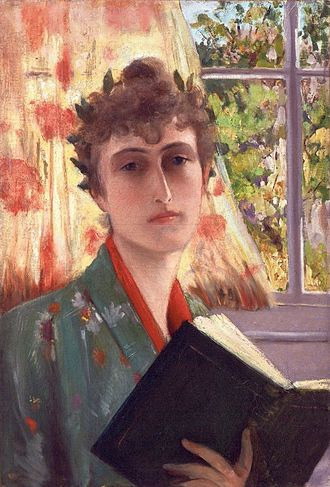
[Though primarily interested in music, Singer also painted, including this self-portrait c. 1885]
Singer was born in Yonkers, New York to the wealthy Singer family (of Singer sewing machines). As was true of many women from newly rich American families, she was married to an old and respectable but financially unstable European family. This was her first marriage, to Prince Louis de Scey-Montbéliard. On her wedding night, she reportedly threatened to kill him if he touched her, and their marriage lasted 5 years before it was annulled, on the grounds that the marriage was never consummated.
The next year, Singer married Prince Edmond de Polignac. Though she was 28 and he was 59, it was a happy marriage, because they were both gay. Singer and her husband were great friends and fellow artists, and Signer was free to pursue women without fear (except, occasionally, of those women's husbands). Singer had a long list of confirmed partners, including American painter Virginia Woolf.
Singer funded a music salon that housed the first performances of such musicians as Chabrier, d'Indy, Debussy, Fauré, and Ravel. Her salon, indeed, was one of the best-observed salons and many of our ideas about salon culture were drawn from the Singer-Poignac salon. She also funded Stravinsky, Milhaud, and multiple ballets.
Singer was a leader in the development of Parisian public housing in the early 20th century, helped convert private limousines into mobile radiology units for World War I (working with Maria Skłodowska-Curie), and helped with the construction of Foch Hospital.
#history#world history#art history#artblr#20th century#badass women#american history#french history#america#united states#france#europe#salons#royalty#royaltycore#gay history#lesbian history#queer history#winnaretta singer#princess#debussy#ravel#stravinsky#ballet#music#paris#hospital#healthcare
383 notes
·
View notes
Text
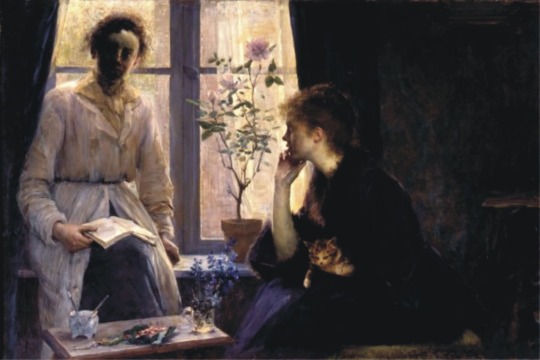

Louise Catherine Breslau - Contre-jour (1887)
Madeleine Zillhardt (June 10, 1863 in Saint-Quentin, France – April 16, 1950 in Neuilly-sur-Seine, France) was a French artist, writer, decorator and painter. Her life and her career are linked to another artist, the German-Swiss painter Louise Catherine Breslau, of whom she was the companion, the muse and the inspirer. They lived together for more than forty years, a life turned towards arts.
In 1884. Zillhardt asked Breslau to make her portrait. They would not leave each other and moved permanently together in 1886. In 1887, Breslau performs 'Contre Jour', one of her masterpieces, representing the couple she formed with Zillhardt in their intimacy. The painting was bought by the Swiss government in 1896, and is today held by the Museum of Fine Arts Bern.
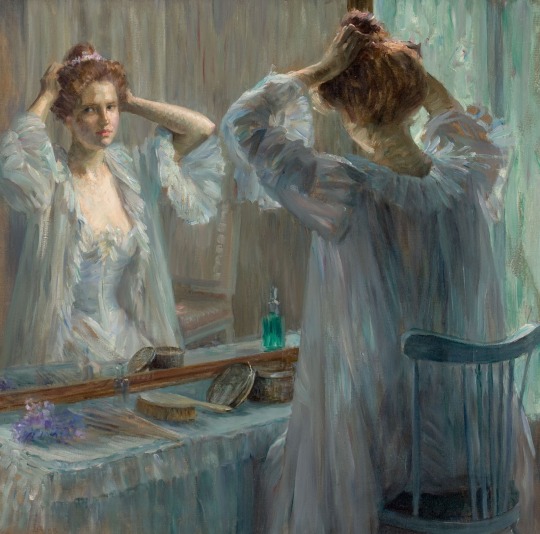
Louise Catherine Breslau - La Toilette (Madeleine Zillhardt), 1898
In 1928, Zillhardt bought the concrete barge 'Liège' in Paris in order to make it available to the Salvation Army. With the support of Winnaretta Singer, princesse de Polignac and heiress of the company of sewing machines Singer, the barge was rehabilitated by Le Corbusier in 1929, with his student, Japonese architect Kunio Maekawa. According to the will of Madeleine Zillhardt, the boat took the name Louise-Catherine in tribute to Breslau and became a refuge for the homeless in winter and a summer camp for children, moored in Paris on the banks of the Seine, at the Pont des Arts and at the Pont d'Austerlitz. (source)
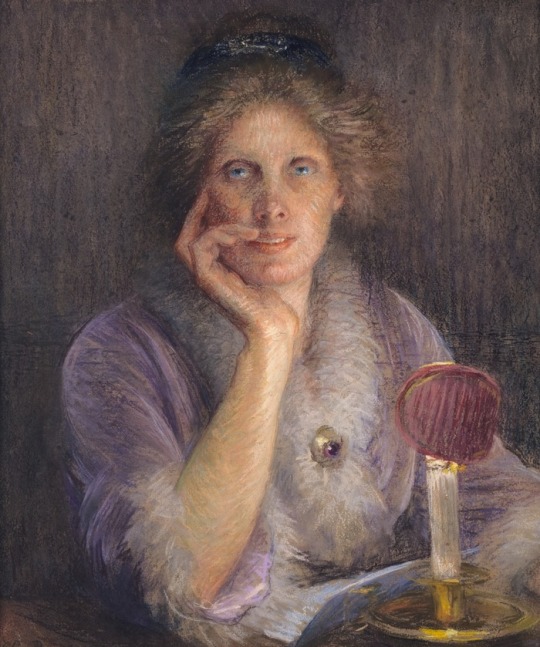

Louise C. Breslau, Sous la lampe. Portrait de Madeleine Zillhardt || Louise Breslau, Self portrait (1891)
73 notes
·
View notes
Photo

Winnaretta Singer (deceased)
Gender: Female
Sexuality: Lesbian
DOB: 8 January 1865
RIP: 26 November 1943
Ethnicity: White - American
Occupation: Entrepreneur, philanthropist
Note 1: Heir to the Singer sewing machine fortune
Note 2: Was an important leader in the development of public housing in Paris. Her 1911 building of a housing project for the working poor at Rue de la Colonie, in the 13th arrondissement, was considered to be a model for future projects.
Note 3: During World War I, working with Marie Curie, she helped convert private limousines into mobile radiology units to help wounded soldiers at the front.
#Winnaretta Singer#lgbt history#lesbian history#lgbt#lgbtq#female#lesbian#1865#rip#historical#white#entrepreneur#heiress#philanthropist#popular#popular post
145 notes
·
View notes
